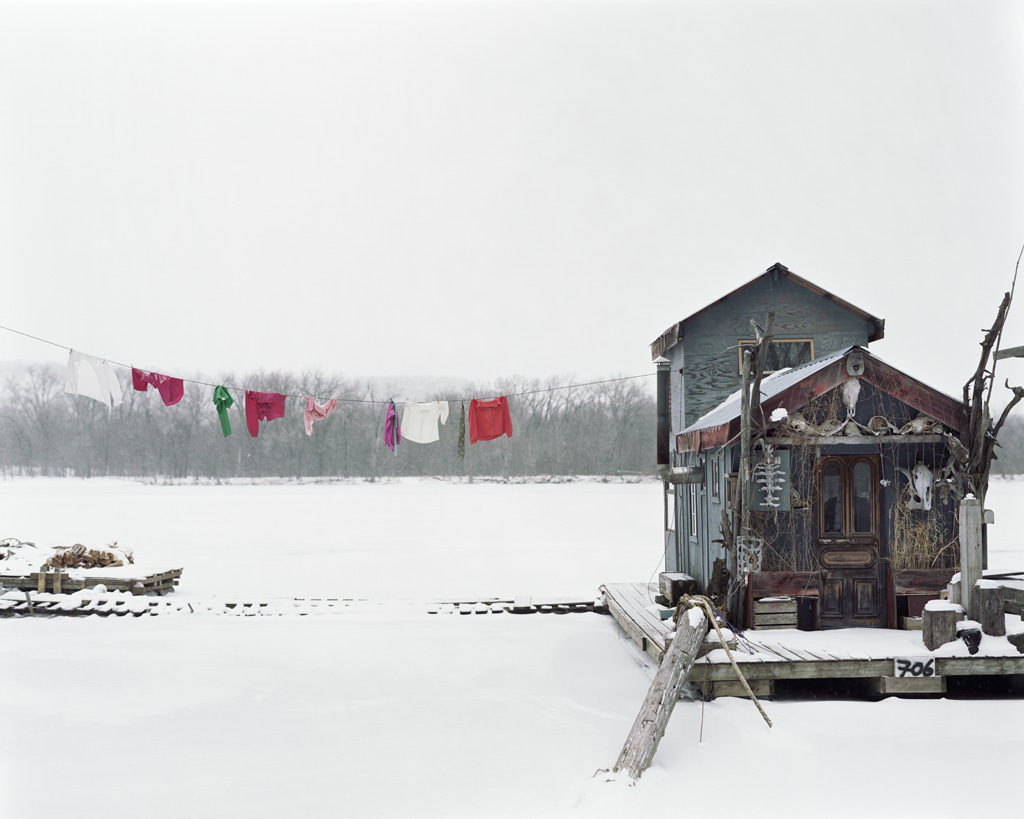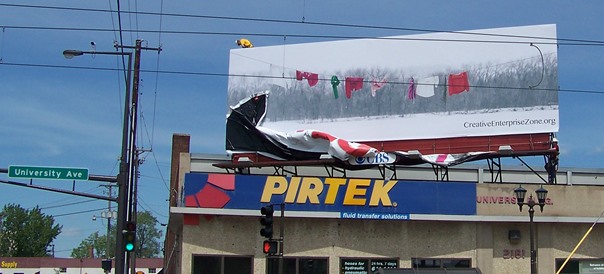
St. Paul’s Creative Enterprise Zone declares itself with a new billboard by photographer Alec Soth
Alec Soth presents his new billboard/”public art intervention” at the intersection of Vandalia and University. Photo by Susannah Schouweiler
Driving down University Avenue, I’ve never paid much mind to the billboards. I see the same forgettably crass ads all over my own working class St. Paul neighborhood promising to “buy ugly houses” and hawking check-cashing services, classic rock radio stations, free pregnancy tests. But take a look next time you’re in the Midway area: at the intersection of Vandalia Street and University, right by the Green Line’s new Raymond Avenue Station, you’ll see an inexplicably artful billboard. If you’re a shutterbug, the image featured might even be a bit familiar: it’s a detail cropped from a quite famous image – a houseboat on the Mississippi River near Red Wing, Minn. – taken by photographer Alec Soth.
Alec Soth, “Peter’s Houseboat. Winona, Minnesota. 2002” from Sleeping by the Mississippi. Via the artist’s website
It’s a winter scene: a clothesline hangs across the backdrop of a leafless and snowbound woods. Hanging on the line is an uncrowded arrangement of garments, an appealing palette of shirts and pants in various shades of red and white; there’s a spritely pair of Kelly green pants, a business-friendly olive print necktie. The string of clothes has an unlikely grandeur against that vista, a bit like the ragtag Tibetan prayer flags you see stranded from dwellings high in the Himalayas. The only text on the billboard is at the base, a website URL: CreativeEnterpriseZone.org.
At the June 3 ceremony, neighborhood entrepreneurs and nonprofit types rubbed elbows with press, local politicians, community organizers and curious bystanders to see the unveiling. The billboard is a “public art intervention,” produced in partnership with Forecast Public Art (a Knight Arts grantee) and real estate developer First and First to raise the visibility of arts-meet-business revitalization efforts underway in the neighborhood, recently rebranded as the Creative Enterprise Zone (CEZ).
Across the street from the soon-to-be revealed billboard, a crowd gathers in front of The Dubliner. Photo by Susannah Schouweiler
In her opening remarks at the press conference, CEZ task force chair Catherine Reid Day noted the neighborhood’s arts-and-culture bona fides, its designation in 1992 as the first Neighborhood Cultural District outside of downtown and its long history of blending creative businesses and commercial storefronts with artists’ spaces, artisanal centers and nonprofit ventures.
The principals here are also residents: Forecast Public Art has been based in the community for 24 years; Alec Soth’s been working out of his studio on Raymond Avenue for eight. First and First has renovated a number of spaces in Minneapolis (e.g. Aria, the Van Buren Building, Icehouse Plaza), but it’s a relative newcomer to St. Paul’s St. Anthony Park neighborhood. They’re in the process of redeveloping some of the grand old warehouse spaces on Vandalia Street.
The CEZ task force came together as construction on the new light rail line got underway. The group was born out of a concern to preserve the diverse character of the neighborhood. Specifically, they’re looking to foster strategic collaboration between arts and business endeavors to leverage the burgeoning redevelopment opportunities in the area in such a way that supports, rather than erodes, what First and First CEO Peter Remes calls the “cohesive mix” that defines it.
They want to evade the perils of unbridled high-end development, to ensure the neighborhood continues to be accessible to the artists and creative entrepreneurial ventures that have historically made the Zone a vibrant place. What’s more, says Day, “we believe artists should be able to make a better living from their creative work. Part of what the CEZ is about is building [cross-sector] relationships” that might put commercial and creative entrepreneurs together in new, profitable partnerships that could improve the whole neighborhood’s lot.
The unveiling. Photo by Susannah Schouweiler
Soth says the clothesline pictured in his billboard was, in fact, hung as an artistic, rather than practical act by the houseboat’s residents that winter. “I chose it for this project because it has the same scrappy, DIY quality, the same spirit of homespun creative activity that I’ve seen happening in the Creative Enterprise Zone.” And that’s good mojo for the community, he says: “Artists just make it more fun.”
Alec Soth’s billboard will be up through June, at least. Forecast Public Art director Jack Becker said they’d love to see a rotation of neighborhood artists in that spot. “It’s such a nice way to signal the creative work happening here, to help make the invisible visible in the CEZ,” he says.
The Creative Enterprise Zone will host a daylong celebration of the Green Line’s launch on June 14 from 9:30 a.m. to 4 p.m. filled with pomp and ceremony and two stages for live performance. There will be food and drink vendors and a bunch of art-making activities led by the diverse array of creative folks who live and work in the neighborhood. Get details about that event on the CEZ website. Find more information about the project, in general, on www.creativeenterprisezone.org.
Recent Content
-
Artsarticle ·
-
Artsarticle ·
-
Artsarticle ·




